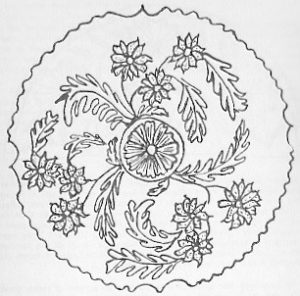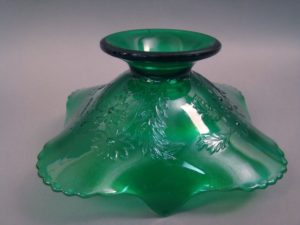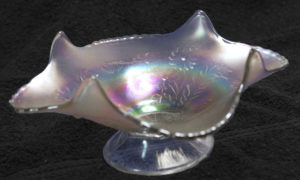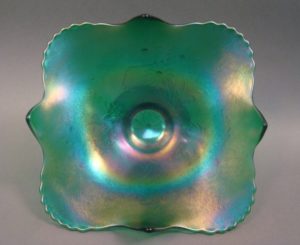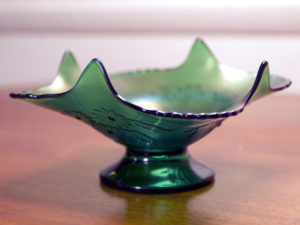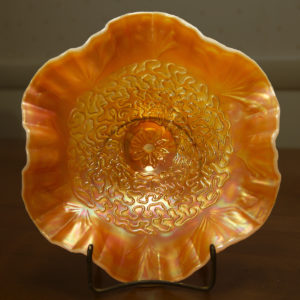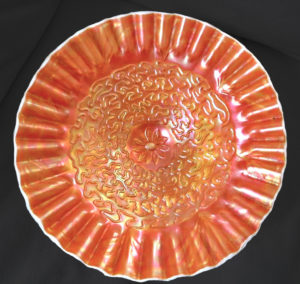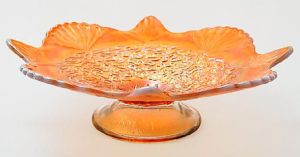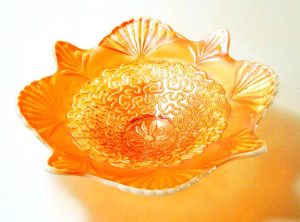by Dr. Larry Keig
Western Daisy is a graceful naturalistic pattern. Soutache is an odd abstract design.
Both scarce, neither Western Daisy nor Soutache are much talked about, probably because they are primarily associated with peach opal, a color not particularly popular with collectors. Soutache, available in several shapes and edge treatments but only in peach, comes up for sale every now and then. Western Daisy, apparently made in variants of a single shape but available in at least three colors, two of them extraordinarily rare, is seen even less frequently.
While not immediately obvious, the two patterns are closely related. They share a common back pattern, can be found with an unique carnival edge treatment, and, in carnival, rest on a domed foot. The two patterns are iridized only on the inner surface.
Marion Hartung’s Western Daisy line drawing illustrates the intricacy of the pattern.
Both are exclusively Dugan, in all likelihood produced from mid- or late-1910 through early 1912. There is no evidence either was made after the firm was bought out by an investor group and renamed the Diamond Glass Company in July 1913.
Dave Doty[s photoshopping of the listing photo shows the pattern detail and its placement on the green square bowl.
Western Daisy
Western Daisy is among Dugan’s prettiest floral patterns. It is realistic, elegant, and asymmetrical. Compared to the stylization of most of Dugan’s floral designs, Western Daisy’s sprays look like they were designed by a prize-winning arranger.
Found on the underside of bowls with a plain obverse, the design consists of four essentially identical sprays, each with three slightly raised stippled blooms with highly embossed stigmas and a number of varieties of veined but non-stippled flanking foliage. The pattern covers the entire surface except for the outermost edge. On the flat undersurface of the three and three-fourth inch or so domed base is a medallion with 12 stippled petals and a button center. Marion Hartung’s line drawing (Fourth Book of Carnival Glass, p. 64) illustrates the pattern detail and placement, as does one of Tom Burns’s listing photos as photoshopped by Dave Doty—both shown here.
Western Daisy is found in what is often called a “whimseyed shape” with alternating points (or flutes) and serrated ruffles (or scallops). There are four of each. Most are round with flared points and ruffles. Occasionally the points are drawn up perpendicular to the surface on which the dome foot rests, creating a visually striking square bowl which might legitimately be considered a whimsey.1
Peach opal. Peach opal is far and away the commonest color, the opal unfortunately often camouflaging much of the gracious design. The surface color, iridescence, and opalescence, wildly variable in quality, range from a vibrant Orange Crush on clear crystal to a lifeless, weak and washed out peach, from an even color covering the entire face to a clear center, from opalescence that blankets all the exterior to only a trace around the outer edge, or a combination of these characteristics. The lighter the color and the larger the clear area, the less desirable and costly a piece is to acquire.
Peach opal Western Daisy bowls are round with top diameters from eight and one-half to nine inches and heights of three to three and one-half inches. Sometimes the points are sharp, at other times rounded. The larger the bowl, the more likely the points are to be rounded.
The two peach opal Western Daisy bowls in this photo, taken by Barb Chamberlain, show the variability of the shaping of the points.
The bowls shown, from the Chamberlain collection, are illustrative. The one with rounded points has a nine-inch top. It had been part of the collection of Bob Bishop until it was auctioned off in 2005. The other, with the sharp points, is eight and one-half inches in diameter. Its provenance is unknown to the current owners.
Satiny White.2 Western Daisy is also known in a satiny white and an intense green, the first of each to be reported. The white had belonged to Bob Bishop until Dean and Diane Fry bought it at his estate auction in November 2005. It remained in the Fry collection until it sold this past September at Seeck Auctions in Iowa.
Diane Highnam’s photo of the white Western Daisy bowl illustrates the elegance of the unusual square shape and edge treatment.
The white is a square whimsey bowl, with alternating upright fluted points and serrated ruffles. It is six and three-fourth inches across points one way, seven inches the other. It measures almost exactly nine inches in both directions across ruffles. It stands three and three-fourth inches tall at the tips of the points, two and five-eighth inches tall at the ruffled edges. Its interior is a multicolor pastel that is transparent enough for the exterior floral pattern to show through. In indirect light, it looks like its base color might be light ice green as it is that green iridescence that dominates although pinks, blues, yellows, and ambers are also in the mix.
Intense Green. The whimsey dark green square bowl is the Cadillac in the Western Daisy line. It is this shape and color which best displays the luxuriant pattern. While the frosty iridescence may or may not qualify as emerald, it is multicolored and vivid, with the predominantly blue and green iridescence and base color exquisitely complementing one another.
At its sharp points, it measures six and three-fourth inches in diameter one way, seven and three-eighth the other. At the serrated ruffles, it is eight and three-fourth inches across one way, about nine inches the other. The points range from four to nearly four and one-half inches tall, the ruffles from about three to three and three-eighth inches.
This photo shows the plain interior of the Western Daisy square bowl.
Gary and Sharon Vandevander, from Lewisburg, West Virginia, found it on eBay in 2005. It sold most recently at the 2017 Tampa Bay convention, conducted by the Burns Auction Service, when the Vandevanders downsized their collection.
The square Western Daisy bowl in green, also photographed by Diane Highnam, is probably the most desirable of all pieces in this pattern.
One More Thing. Western Daisy and Daisy Dear are sometimes said to be nearly identical patterns. In reality, they are totally different. While both of their exteriors are made up of four floral sprays, Daisy Dear’s is simpler. Each of its sprays has a single blossom and minimal leafage. The flowers and leaves of Daisy Dear occupy considerably less of the surface than the more capacious Western Daisy. There’s a subtlety to Western Daisy that is absent on Daisy Dear.
Soutache
Soutache is essentially Western Daisy with an added curious interior pattern. According to Marion Hartung (Sixth Book of Carnival Glass, p. 50), soutache, the dominant element, is an ornamental braid used to decorate fabric. This braiding fills the inner two-thirds of the surface. The other element, occupying the surface between the soutache embroidery and the outer edge, is an alternating larger-and-smaller fan-like floral design, with blossoms that look like they were plucked from their stems.
Bowls. Soutache is found in bowls and plates. Bowls, which measure from eight and one-half to nine inches in diameter, are available in a number of edge treatments. The most common is the six-ruffled, which can be found with a smooth (non-crimped) edge or with a tightly-crimped edge. They are also available in the “Western Daisy shape,” with the alternating fluted points and serrated scallops. Everything else being equal, the alternating fluted-and-scalloped version is more desirable than the ruffled.
All known Soutache bowls are round and flared. None have been reported in the square shaped with the pulled-up sharp points. If this configuration were available, it would surely be the most desirable bowl shape.
The ruffled and tightly-crimped Soutached bowl is a common shape but an especially pretty peach opal, as Diane Highnam’s photo illustrates.
The peach opal Soutache bowls are tremendously variable in quality of color. Some are vibrant, others pallid with a weak peach overlay or completely clear in the center. Some have exteriors that are entirely covered with opalescence, others have only a modicum of opal, some with opalescence only at the outermost edge.
Dick and Diane Weatherbee’s photo of the tightly crimped Soutache plate shows just how attractive Dugan’s peach opal can be, especially against Brian Pitman’s photoshopped dark background.
The illustrated six-ruffled and tightly-crimped bowl, with sunny peach surface color, was purchased long ago from one of John Resnik’s thick “For Sale” lists. Lists like this were a means by which much carnival was bought and sold in an era before home computers and eBay made them obsolete. This is the same John Resnik who authored the still widely referred to Encyclopedia of Carnival Glass Lettered Pieces.
The whimsied Soutache plate, once in the Britt collection, is the most desirable plate shape. Dave Doty’s photos illustrate the pattern details and great color.
Plates. Even harder to find than bowls, the plates are larger, measuring in the neighborhood of nine and one-half inches in diameter. The ten fan-like flowers are more prominent on plates than bowls.
Plates are available in three edge treatments: (a) a true flat plate with smooth edge, (b) a not-quite-so-flat plate with a tightly-crimped edge, and (c) a plate in the Western Daisy style, with alternating rounded flutes and serrated ruffles. Crimped plates are seen more often than the flat and the pointed-and-scalloped.
The color quality of plates is inconsistent. Some are colorful, with bright, even peach overlay. Others are at best borderline, some even worse. Coming up with one with good color in any of the shapes is challenging. A flat plate, with surface color and iridescence that are ugly as sin has been listed off and on for years on eBay at an exorbitant price. It is not likely to change hands until the owner’s estate is settled.
Yet handsome plates can be found, if a collector is patient enough to wait for one to surface. The large tightly-crimped plate, which sold recently on eBay, shows just how pretty Dugan peach opal can be. The color is both bright and even. It had been in Dick and Diane Wetherbee’s collection until it changed hands this November. The photo is theirs, with Brian Pittman’s photoshopping of the background.
The whimsied “Western Daisy-style” plate, shown from two angles, is also an example with really nice color. It had been in John and Lucile Britt’s collection until it sold at one of their auctions; this one the 1998 ICGA convention in Kansas City. The Britts were major promoters of carnival; John a prolific writer of articles for The Carnival Pump and other publications. The photos are Dave Doty’s.
Notes
1An item may have been whimsied without actually being a whimsey. A piece that has been whimsied is oddly shaped but available in some quantity. Whimsies, also oddly shaped, are known in very limited numbers, often a single example having been reported.
2There is some dispute as to surface color. While the previous and current owners say it is white, some of those who attended the auction at which it recently sold believe it has a light marigold overlay or is “something else.” My guess is that the intense artificial lighting at the auction venue created an illusory effect that made the color look different from what it actually is.
Larry.Keig@cfu.net

